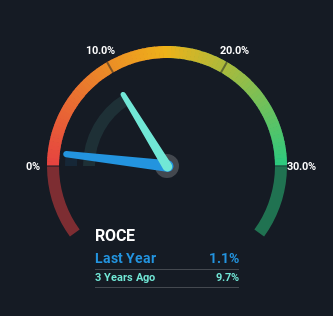Smith-Midland (NASDAQ:SMID) Might Be Having Difficulty Using Its Capital Effectively
If you're not sure where to start when looking for the next multi-bagger, there are a few key trends you should keep an eye out for. One common approach is to try and find a company with returns on capital employed (ROCE) that are increasing, in conjunction with a growing amount of capital employed. This shows us that it's a compounding machine, able to continually reinvest its earnings back into the business and generate higher returns. Having said that, from a first glance at Smith-Midland (NASDAQ:SMID) we aren't jumping out of our chairs at how returns are trending, but let's have a deeper look.
Understanding Return On Capital Employed (ROCE)
For those who don't know, ROCE is a measure of a company's yearly pre-tax profit (its return), relative to the capital employed in the business. Analysts use this formula to calculate it for Smith-Midland:
Return on Capital Employed = Earnings Before Interest and Tax (EBIT) ÷ (Total Assets - Current Liabilities)
0.011 = US$502k ÷ (US$58m - US$13m) (Based on the trailing twelve months to September 2023).
Thus, Smith-Midland has an ROCE of 1.1%. Ultimately, that's a low return and it under-performs the Basic Materials industry average of 11%.
Check out our latest analysis for Smith-Midland
Historical performance is a great place to start when researching a stock so above you can see the gauge for Smith-Midland's ROCE against it's prior returns. If you're interested in investigating Smith-Midland's past further, check out this free graph of past earnings, revenue and cash flow.
So How Is Smith-Midland's ROCE Trending?
On the surface, the trend of ROCE at Smith-Midland doesn't inspire confidence. Over the last five years, returns on capital have decreased to 1.1% from 3.8% five years ago. However, given capital employed and revenue have both increased it appears that the business is currently pursuing growth, at the consequence of short term returns. If these investments prove successful, this can bode very well for long term stock performance.
The Bottom Line
While returns have fallen for Smith-Midland in recent times, we're encouraged to see that sales are growing and that the business is reinvesting in its operations. And the stock has done incredibly well with a 481% return over the last five years, so long term investors are no doubt ecstatic with that result. So should these growth trends continue, we'd be optimistic on the stock going forward.
One more thing to note, we've identified 2 warning signs with Smith-Midland and understanding them should be part of your investment process.
While Smith-Midland may not currently earn the highest returns, we've compiled a list of companies that currently earn more than 25% return on equity. Check out this free list here.
Have feedback on this article? Concerned about the content? Get in touch with us directly. Alternatively, email editorial-team (at) simplywallst.com.
This article by Simply Wall St is general in nature. We provide commentary based on historical data and analyst forecasts only using an unbiased methodology and our articles are not intended to be financial advice. It does not constitute a recommendation to buy or sell any stock, and does not take account of your objectives, or your financial situation. We aim to bring you long-term focused analysis driven by fundamental data. Note that our analysis may not factor in the latest price-sensitive company announcements or qualitative material. Simply Wall St has no position in any stocks mentioned.

